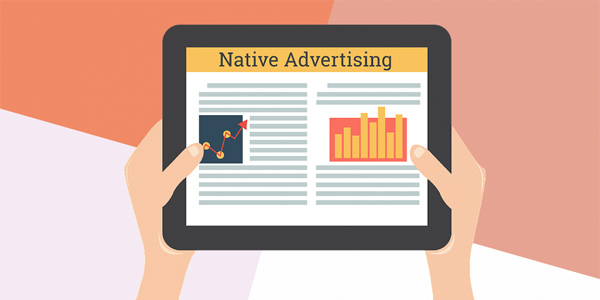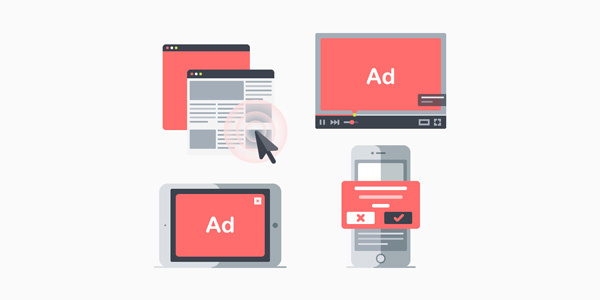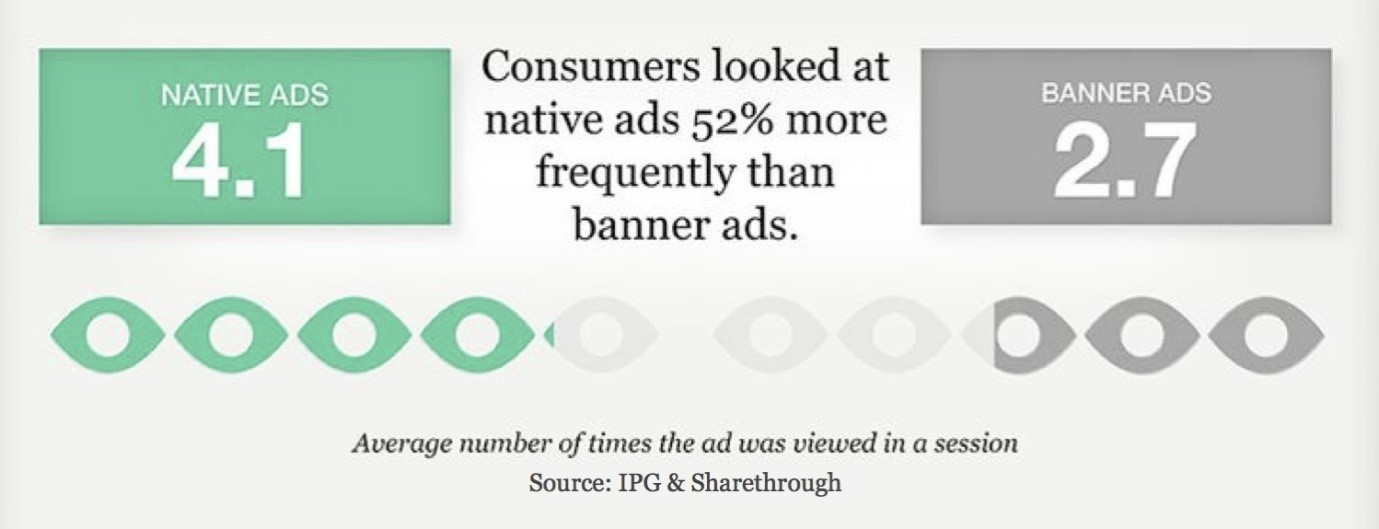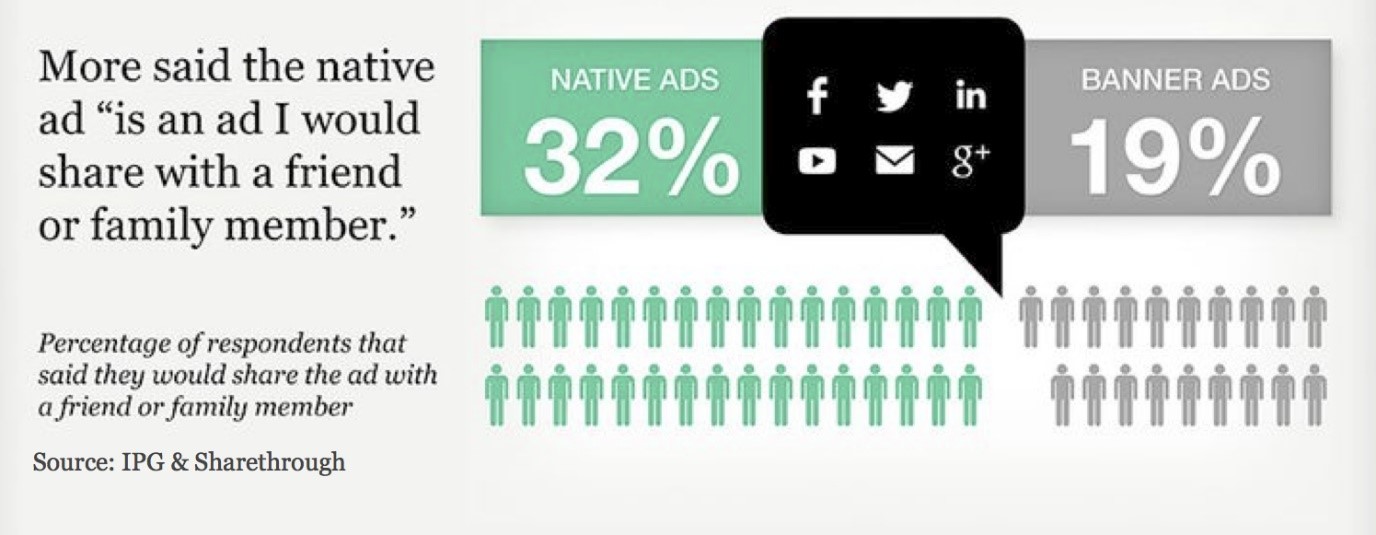- Tools
- Learn
- Help
Before you leave..
Why not download RevGlue latest free eguide.


Native advertising quite simply refers to paid content, which is so cleverly interwoven into website content that it does not appear to be advertising at all. The paid native advertising content can take the form of blog posts, articles, and infographics.
The whole aim of native advertising is to ensure that the user experience is not interrupted and that the native advertising blends into the content extremely seamlessly. Native adverts are designed to mirror the language, style and layout of the platform they are on, and to attract the target audience of the platform without being detected as an advert by the audience.
Sometimes referred to as sponsored content or promoted posts, native ads align with the organic content and niche of the platform and are not presented as adverts.
For affiliate marketers, native ads present a great opportunity to maximise their marketing and generate passive income in an organic way and overcome consumer ad fatigue. Native ads can be incorporated into content in a natural and intuitive way, and this tactic ensures that the affiliate marketer can achieve optimum consumer and audience engagement.

Native ads are everywhere, they can be found on websites, social media platforms, and shopping channels. The most common types of native advertising are:
In-app native ads
In-app native ads seamlessly blend into the app, matching the language, font, style, and graphics of the app. Statistics show that in-app native ads are three times more likely to be viewed than banner ads.
In-feed native ads
In-feed native ads are probably the most powerful form of native ads. They are strategically placed in and amongst organic content so that audiences and readers do not always realise they are viewing an ad. In-feed native ads are subtle and aim not to interrupt the user experience, and are commonly used by the largest social media platforms including Twitter, LinkedIn, and Facebook.
Email Widgets
Email widgets in the form of native ads are aimed at emails and are used by companies and brands which infiltrate their email marketing with native ads. These native ads do not run automatically and only feature when the user opens the email.
Sponsored ads
Sponsored ads are created in collaboration with influencers, affiliate marketers or, publishers.
Advertorials
These are usually placed on social media platforms, but are also used in newspapers and magazines
What native advertising looks like

The native advertising market is set to be worth over $400 billion globally by 2025. In Europe, the UK is the largest native ads market with native ad spending in 2020 amounting to approximately £20 million. Statistics show that:
• Native ads are 53% more frequently viewed than display ads
• The click-through rate for native ads is 40% higher than other display ads
• 25% more consumers look at native ad placement when compared to other ads
• Consumers find native ads more appealing and engaging than other ads

How affiliate marketers should use native ads

Affiliate marketers can enhance the success of native ads by doing the following:
1. Promoting content: using social media platforms, websites, and blogs, affiliate marketers should use native ads within their content to expose them to larger audiences.
2. Drive traffic to sites: good quality and relevant content will result in traffic to your site. Great content helps affiliate marketers to build a solid and loyal following, enabling affiliates to set themselves up as an authority in a certain field. As native adverts mimic and incorporate content, they can easily be interwoven into organic content.
3. Promotion: affiliate marketers should use all their social media platforms to promote their content and their native ads. Loyal followers will devour your content, and with native ads interspersed into the content affiliates can achieve high exposure for the native ads, and this, in turn, leads to high engagement rates.
4. Email list: a long and substantial email list means you can email your content and native ads direct to consumers. This creates brand awareness, strengthens your own visibility, and can lead to conversions.
Why affiliates should start running native ads now

Some of the key benefits of native ads, when used by affiliate marketers include the following:
• Attention-grabbing: as mentioned, native ads are designed to blend into the organic content and this means that they are attention-grabbing and increase engagement rates. For affiliate marketers, the key to success is engagement, therefore native ads are better than other forms of traditional advertising.
• Control: advertisers typically like to be able to control the output of their ads, and native ads facilitate this level of control. Companies can dictate the placement and target consumers accurately by choosing the right affiliate. Affiliate marketers retain their control by taking ownership of the message being sent.
• More likes and shares: with likes and shares being the coveted online currency, native ads succeed in ensuring that engagement levels with audiences are high. As native ads are interwoven and presented as content-based, they invoke more engagement and therefore increase brand awareness in a natural way.
• Device and reach: as native ads are absorbed as part of organic content, they are easily adjustable to any device including desktops and mobiles. This means the reach of the native ad is wide-ranging.
• Less ad blocking: consumers do not object to native ads and therefore do not always feel the need to block them as they would with standard ads.
• Empower consumers: native ads present branded content in a natural way to consumers, making them feel that they are being provided with solution-based information.
• Loved by millennials: according to IAB, millennials prefer and trust native ads over other forms of advertising online. Millennials see native ads as authentic and non-disruptive.

Affiliate marketing relies on authentic audience relationships, and trust based on recommendations and reviews. The most successful affiliate marketers are those who have built a personal brand and a loyal following. Followers these days are suffering ad fatigue, they don’t want to be constantly sold to. Therefore, affiliate marketers are keen to maintain the authenticity of their following by making sure their content is organic and relevant.
Native ads enable affiliate marketers to sell products and drive traffic to their affiliate links without hard selling. The native ads appear to followers as relevant and niche-related content, thereby boosting engagement and affiliate income.
How native ads differ from other advertising

The main difference is, of course, the fact that native ads are content-based, and interweave with the organic content alongside which they are placed. Audiences are not disrupted or jarred away from, organic content when they are browsing. The main differences from other types of ads are as follows:
• They are non-disruptive
• Non-deceptive: the aim of native adverts is not to deceive, but rather to blend into other content. Everything within the native ad is transparent.
• Camouflaged: native ads are the opposite of banner ads, which are displayed as very obvious adverts. In contrast, native ads are camouflaged amongst natural content.
Differences between content marketing and native ads
There is an overlap between content marketing and native ads. Native ads are essentially targeted content, and like content marketing, the goal is to promote products and services. However, there are some key differences between content marketing and native ads.
The focus of content marketing is about building a loyal audience and following that will ultimately help you rank higher in the search engine results. Content marketing seeks to improve traffic and visibility. Native advertising is paid content that is seamlessly presented as authentic and organic content.
Usually hosted on third-party websites, native ads use space that is paid for by the affiliate marketer or advertiser. Where content marketing involves inbound marketing strategies that require your own platform and your own audience, native ads are more outbound facing as they rely on paid media and audiences often belonging to third-party sites and platforms.
User Experience And Native Ads

For any marketing campaign to be successful, user experience is a vital consideration. Native ads rely on being able to get and retain the attention of their audience. Great content, clear messages, good landing pages,and seamless interactions of these elements all increase the user experience.
For a native ad to really work, the ad should blend in seamlessly with the content on the particular platform it is on. You should ensure that your native ad is placed well, and is not disruptive to the user. The content on the site and the native ad should flow well and add to the content where possible.If the native ad is not in line with the content on the site, then it will not resonate with your audience, and this will mean you have fewer conversions.
Ways you can improve the user experience:
• Avoid click-bait to drive traffic, this increases your bounce rate and you lose audience trust
• Improve your targeting by choosing the right platforms and audiences to target
• Place your native ads in the right place
• Test out different platforms, formats, content, and creatives.
• Learn more about your audience. Surveys and questionnaires will help you get important information about your audience, and you can then plan your campaign in a more targeted way.
Choosing the right offers for native ads

For native ads to work the best, affiliate marketers should choose the right pay-outs and the most appropriate niches. Native ads work best on niches such as health and beauty, fitness, gaming, trading, and finance. The reason for this is those native ads can be incorporated into these niches in timely and constructive ways, in ways that can authentically target the right audiences.
Choosing the right native ads network

When deciding on which native ads network to choose, affiliate marketers should always consider the following:
1. Audience: your audience is key if you want to ensure that your native ads strategy is successful. You want to ensure that you target the right audience, in the right location. For example, if you want to advertise local attractions in the UK then you should target UK audiences, and preferably those close to the location you are advertising.
2. Bidding Models: There are a variety of bidding models you can use for your native ads. Depending on what your budget is and what your native ad is related to, the bidding model will vary. The types of bidding models include the following:
• Manual cost per click (CPC)
• Target cost per conversion (CPC)
• Cost per action (CPA)
• Cost per impression (CPM)
• Cost per view (CPV)
3. Targeting (options): Think about and choose your targeting options carefully. Different technologies are offered for different native ads platforms. Check to see how each platform enables you to target the audience you want and consider the options which go beyond location and device targeting. Some networks will let you target specific websites, whilst others will limit what sites your native ads will appear on.
4. Price: different native ad networks have different costs. You need to assess whether the cost of using the network works for you or not. Additionally, there are some networks that have a minimum spend for advertisers and affiliates, so make sure you work out what your budget is before deciding on the network to use.
5. Ad Formats: the format of your native ad is important, especially if you want to realise the benefits of your creative visions. The types of ad formats you can choose from include:
• in-feed units which will appear in blogs and social media feeds
• Promoted listings that appear on e-commerce sites, or on blog sidebars
• Paid ads that appear in search engine results
• Widgets that appear on websites
6. Reporting: a crucial element when it comes to choosing the right native ads network for you is to understand the reporting capabilities of the network. For successful affiliate marketing using native ads, you need to have access to all the data relating to your native ads. You should look to see if you will be provided information relating to the following:
• Key performance indicators
• Analytical reports
• Custom reports
• Report filters
Some of the more popular native ads networks include Outbrain, Taboola, Revcontent, and Media Native.
Native ads and landing pages

In addition to making sure the targeting of the native ad is correct, affiliate marketers should also ensure that landing pages are able to capture your consumer when they click on it. You should make sure that the landing pages you use are creative, engaging, and attractive if you want a high conversion rate. A well-designed landing page will help you out-manoeuvre your competitors with your ads who might be running similar ads on similar sites.
The landing page should have the right message to match your ad, a great structure, and a good design. You should seek to align your native ads and your marketing strategy with a good landing page, as each element will complement the next and improve the success of the overall ad campaign. Tracking the performance of your landing pages using tracking pixels will enable you to understand if your native ads campaign is working or not. The type of tracking information you should be aware of includes things like clicks, interactions, check out initiations, scrolling depth, time on page, and bounce rates.
Here are some requirements when it comes to landing pages, they should:
• Have high-quality images
• Align with your ad campaign
• Have no grammatical or typing errors
• Have a clear and concise message
• Use language that matches your ad
• Have high-quality content, links, and original content
• Contain testimonials if possible
• Have no paywalls or barriers to access the site, such as registration panels
• Popups that can easily be closed
• Have clear navigation bars
Targeting

As with any form of marketing and advertising, the targeting of the audience is one of the most important elements of any native ads campaign. If you target the wrong audience, then your affiliate marketing and native ads campaign is likely to fail. When preparing your native ads campaign you should identify your target audience and market, this will mean that the ad campaign strikes a chord with the right people, and is more likely to lead to higher conversion rates.
In addition to knowing who your target market and the audience is, affiliate marketers should also research the location and geography of target consumers, the timing of the ads, media channels, content, and the types of sites to use.
For optimum results, you should monitor the success of your targeting by checking up on your tracking information. One good strategy is to set up separate campaigns on different landing pages to see which campaign works best. If you need to, change your structure, text, and overall message until you feel you have the right targeting strategy.
Targeting does not only relate to new customers, don’t forget the importance of retargeting website visitors and those who have shown an interest in previous campaigns.
Summary
If you are an affiliate marketer and you are considering the various advertising options available to you, then you definitely need to include native advertising in your campaigns and promotions. Native ads are attention grabbers, and the conversion rates are higher than other forms of advertising. The main benefit for affiliate marketers, other than the income generated, is that native ads don’t turn off audiences. For any affiliate marketer who has built a loyal following, retaining their audience is a key component of their success, and native ads do not alienate audiences or big brands.